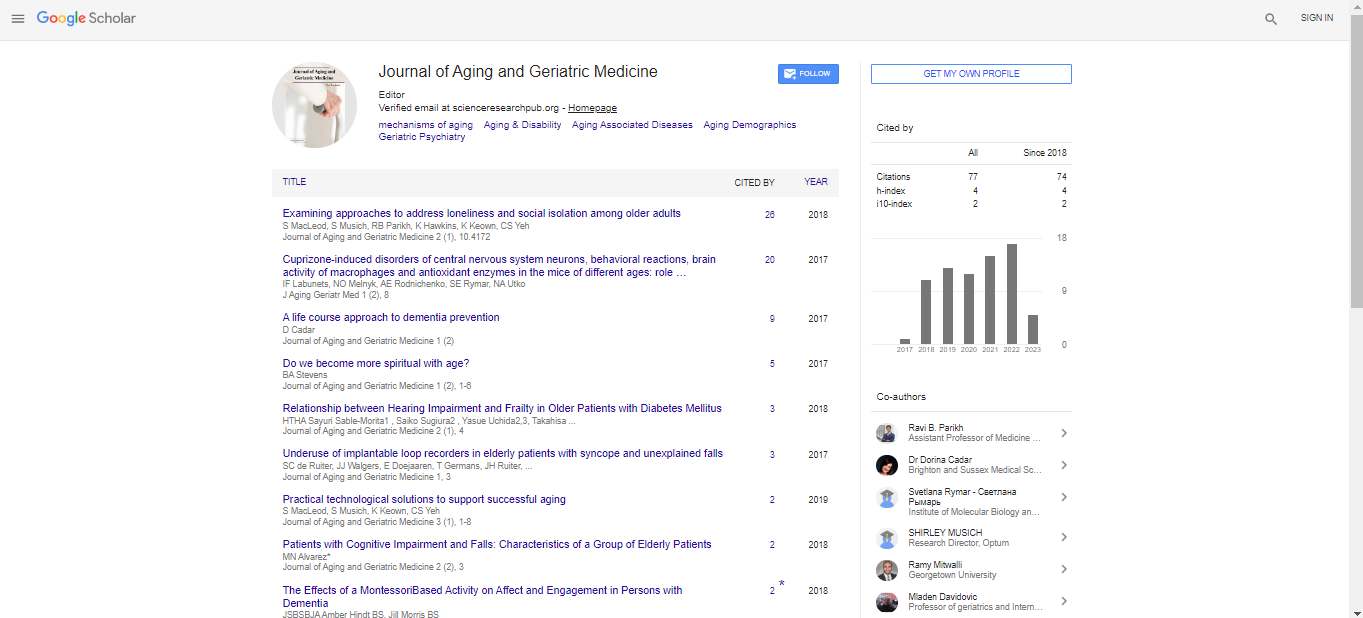Short Communication, J Aging Geriatr Med Vol: 7 Issue: 3
Aging with Residual Schizophrenia: Challenges and Coping Strategies
Kelly Mu*
1Department of Clinical Medicine, Aarhus University, Aarhus, Denmark
*Corresponding Author: Kelly Mu,
Department of Clinical Medicine, Aarhus
University, Aarhus, Denmark
E-mail: mukelly@gmail.com
Received date: 21 April, 2023, Manuscript No. AGM-23-102336;
Editor assigned date: 24 April, 2023, PreQC No. AGM-23-102336 (PQ);
Reviewed date: 15 May, 2023, QC No. AGM-23-102336;
Revised date: 22 May, 2023, Manuscript No. AGM-23-102336 (R);
Published date: 29 May, 2023, DOI: 10.4172/2576-3946.1000157.
Citation: Mu K (2023) Aging with Residual Schizophrenia: Challenges and Coping Strategies. J Aging Geriatr Med 7:3.
Abstract
Description
Residual schizophrenia is a subtype of schizophrenia characterized by a history of at least one episode of schizophrenia, but with prominent negative symptoms and a relatively stable course [1]. It is important to note that the term "residual schizophrenia" is no longer used in the current edition of the Diagnostic and Statistical Manual of Mental Disorders, which is the standard diagnostic manual for mental health disorders.
Schizophrenia can manifest and affect individuals throughout their lives, including older adults. While the onset of schizophrenia typically occurs in late adolescence or early adulthood [2]. At any age, residual schizophrenia might manifest. Generally men and women experience schizophrenia at different ages. This mental disease typically strikes men in their late teens or early 20s. For women, the start occurs between the ages of 20 and 30. Once the symptoms stop, individuals can enter the residual phase [3]. These signs may last for weeks or even months.
Older persons with schizophrenia exhibit great variation in symptom intensity, quality of life, and overall outcomes due to the heterogeneity of the condition [4]. Many people maintain consistent disease remission, while a few show persistent nonremission and a few have changing symptoms. Although suicide rates are greater than those of age-matched peers, depression is frequently noted, and the increased mortality in this cohort is primarily due to natural causes of death [5]. Reduced disease awareness and cognitive deterioration have significant effects on functional status and quality of life.
The symptoms of schizophrenia can vary from person to person, but they generally fall into three categories: positive symptoms (e.g., hallucinations, delusions) negative symptoms (e.g., reduced motivation, social withdrawal), and cognitive symptoms (e.g., difficulties with attention and memory) [6]. In older adults, negative symptoms and cognitive impairments may be more pronounced, while positive symptoms may be less prominent compared to earlier stages of the illness.
A subtype of schizophrenia known as residual schizophrenia is characterised by decreased positive symptoms but persistent negative symptoms. Positive signs of schizophrenia include ideas or actions that were absent prior to the onset of the mental disorder. They are paranoia, delusions, and hallucinations [7].
Negative symptoms are modifications to prior ideas and behaviours. Social withdrawal, strange thinking, and interest loss are some examples [8]. A person with residual schizophrenia may no longer experience hallucinations and delusions, but they still experience other symptoms like loss of interest.
The use of antipsychotic medications is a common treatment approach for schizophrenia. However, older adults may be more vulnerable to the side effects of these medications, such as sedation, movement disorders, or cognitive impairment [9]. Close monitoring and individualized medication management are crucial to minimize these risks.
It is essential for older adults with residual schizophrenia or any form of schizophrenia to receive appropriate and individualized care. Treatment typically involves a combination of medication, psychotherapy, and psychosocial support [10]. Family involvement and community resources can also play significant roles in providing support and enhancing the quality of life for older adults with schizophrenia. Aging itself brings about various physiological and cognitive changes. Older adults with schizophrenia may experience additional challenges associated with age-related declines in physical health, cognition, and sensory functions. These changes can further complicate the management of the illness.
References
- Naylor L, Dean B, Opeskin K, Pavey G, Hill C, et al. (1996) Changes in the serotonin transporter in the hippocampus of subjects with schizophrenia identified using (3H) paroxetine. J Neural Transm 103: 749-757.
[Crossref] [Google Scholar] [Pubmed]
- Hernandez I, Sokolov BP (1997) Abnormal expression of serotonin transporter mRNA in the frontal and temporal cortex of schizophrenics. Mol Psychiatry 2: 57-64.
[Crossref] [Google Scholar] [Pubmed]
- Kirov G, Pocklington AJ, Holmans P, Ivanov D, Ikeda M, et al. (2012) De novo CNV analysis implicates specific abnormalities of postsynaptic signalling complexes in the pathogenesis of schizophrenia. Mol Psychiatry 17: 142-153.
[Crossref] [Google Scholar] [Pubmed]
- Carthy Mc, Makarov V, Kirov G, Addington AM, McClellan J, et al. (2009) Microduplications of 16p11.2 are associated with schizophrenia. Nat Genet 41: 1223-1227.
[Crossref] [Google Scholar] [Pubmed]
- Vacic V, McCarthy S, Malhotra D, Murray F, Chou H, Peoples A et al. (2011) Duplications of the neuropeptide receptor gene VIPR2 confer significant risk for schizophrenia. Nature 471: 499-503.
[Crossref] [Google Scholar] [Pubmed]
- Rees E, Kirov G, Sanders A, Walters JTR, Chambert K, et al. (2014) Evidence that duplications of 22q11.2 protect against schizophrenia. Mol Psychiatry 19:37-40.
[Crossref] [Google Scholar] [Pubmed]
- Fromer M, Pocklington J, Kavanagh H, Williams H, Dwyer S et al. (2014) De novo mutations in schizophrenia implicate synaptic networks. Nature 506:179-184.
[Crossref] [Google Scholar] [Pubmed]
- Fleischhacker W, Arango C, Arteel P, Barnes TR, Carpenter W, et al. (2014) Schizophrenia-time to commit to policy change. Schizophr Bull 40: S165-S94.
[Crossref] [Google Scholar] [Pubmed]
- Andreasen NC (1996) Pieces of the schizophrenia puzzle fall into place. Neuron 16:697-700.
[Crossref] [Google Scholar] [Pubmed]
- Fletcher PC, Frith C, Rugg MD (1997) The functional neuroanatomy of episodic memory. Trends Neurosci 20: 213-218.
[Crossref] [Google Scholar] [Pubmed]
 Spanish
Spanish  Chinese
Chinese  Russian
Russian  German
German  French
French  Japanese
Japanese  Portuguese
Portuguese  Hindi
Hindi 